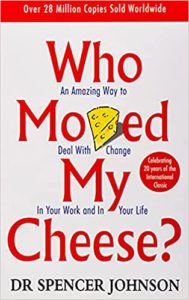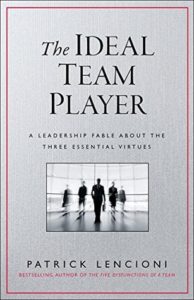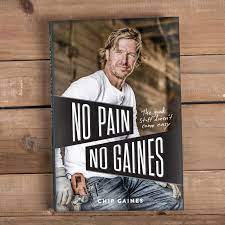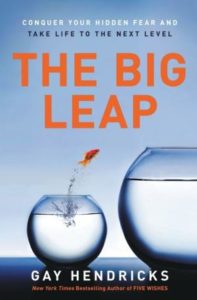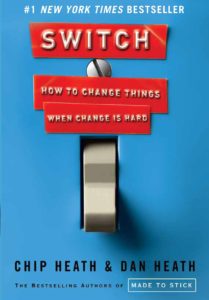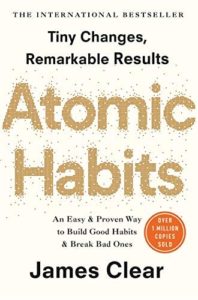
The Leap Team loves a good book or two or ten. If you peeked at our book purchases, you’ll see the diversity of our interests. We figured our newsletter readers would like to see what we have been reading and using in our work with our clients. Enjoy this year’s Team Leap Summer Book Club selections! Reading a book is a good thing to do and with the ability to read, listen and sometimes even watch a book or story on stage or on a screen, it is time to make your next summer reading selection. Here are some of ours…
Books reviewed in this issue of our newsletter:
- Think Again
- The Happiness Lab Podcast
- The Anxious Achiever
- Yours Truly
- Finding Latinx
- Be an Awesome Boss
- Surf When You Can
- The Confidante
- Necessary Endings
By Adam Grant
Publisher: Atria Books
ISBN-10: 1982191007
Reviewed and re-thought by Chuck McPherson ~ The Power of Knowing What You Don’t Know – In the book by Adam Grant, “Think Again”, he provides his top 30 practical takeaways. I am listing a few here in hopes that you will “Think Again” after reading them.
Developing the Habit of Thinking Again
1. Think like a scientist
When you start forming an opinion, resist the temptation to preach, politick or prosecute. Treat your emerging thoughts as a hunch or hypothesis and test it with data. Here at Leap, we always encourage people to be curious by asking more questions and getting more information.
2. Define your identity in terms of values, not opinions
See yourself as someone who values curiosity, learning, mental flexibility and searching for knowledge. As you form opinions, keep a list of gators that would change your mind.
Calibrate your Confidence
3. Be aware of getting stranded at the summit of Mount Stupid
Don’t confuse confidence with competence. To prevent overconfidence in your knowledge, reflect on how well you can explain a given subject.
4. Harness the benefits of doubt
If you find yourself doubting your confidence, reframe the situation as an opportunity for growth. Knowing what you don’t have is often the first step towards developing expertise.
5. Embrace the joy of being wrong
Mistakes are really a discovery of something new. It can help you focus less on proving yourself and more on improving yourself.
Invite Others to Question your Thinking
6. Learn something new from each person you meet
Everyone knows something more than you about something. Ask people what they have been thinking about lately or start a conversation about times you’ve changed your mind in the past year.
7. Build a challenge network not just a support network
Although it’s helpful to have people encouraging you, you also need critics to help you think deeper and poke holes in your thinking.
8. Don’t shy away from constructive conflict
Disagreements don’t have to be disagreeable. Try framing disagreement as a debate. People will be more likely to approach it intellectually and less likely to take it personally.
These are a few thoughts from Adam’s book and there are plenty more. As with most business books, there are new thoughts and repackaged thoughts that can spur a different approach to thinking and contemplating.

The Happiness Lab
A Podcast by Dr. Laurie Santos
https://www.drlauriesantos.com/happiness-lab-podcast
Happily reviewed by Jen Chelini ~ If you had to guess, what do you think the most popular class at Yale has been in its 300-year history? It may surprise you. Dr. Laurie Santos, a psychology and cognitive science professor teaches a psychology course entitled “Psychology and the Good Life”. Dr. Santos explores the latest scientific research and shares inspiring and often surprising stories that will change the way you think about happiness. Many of us do the exact opposite of what it takes to be happy or make our lives richer.
What is really interesting is how Dr. Santos began teaching this course, which later fueled the natural outgrowth of the podcast, “The Happiness Lab”. As head of one of Yale’s colleges, Dr. Santos was required to live on campus. What she discovered was that students were less happy than she thought they would be. So, she had the idea to teach a class on happiness, with the idea that if students understood the science behind happiness their lives and happiness would improve. Thinking 30-40 students would enroll in the class, was she surprised when 1,200 students registered!
Podcast episodes from “The Happiness Lab” dive into exploring the uphill battle we find ourselves in when we are truly trying to find happiness. The Happiness Lab’s goal is to improve the listeners’ lives by helping them seek a better path toward a happier life. The podcast supports this with expert guests, scientific facts, and experimental projects and stories.
The podcast reaches beyond the college hallways and addresses how non-college folks are struggling with the happiness factor too. Dr. Santos addresses technology and how it has led to less interaction and more transactions. For example, using an ATM versus talking to a bank teller. She also points out how simple, positive interactions with strangers can bump our mood way more than expected. Even the idea of simply being social makes us feel the best – more so than eating, shopping, relaxing, or watching television.
The stories are the most fun to listen to. To give you a little taste…. a study out of the University of Chicago gave people $10 Starbucks gift cards to talk to strangers on the train. Most thought this would be awkward or weird, but after their trip, surveys showed that commuters found they experienced a better mood/more happiness when making a connection with someone they did not know.
Hosted by Dr. Santos, the podcast is uplifting, engaging, and very informative. I encourage you to give it a try!
By Morra Aarons-Mele
Publisher: Harvard Business Review Press
ISBN-10: 164782253X
Reviewed by Tracy Emmerich ~ I chose this book because, like many people in this world, I have struggled with anxiety. There were times in my career I felt the anxiety I experienced held me back from achieving my true potential. “The Anxious Achiever” looks at struggles faced by high achievers with anxiety. Morra Aarons-Mele combines personal experiences and in-depth research to shed light on such a prevalent issue.
While reading the book, I found myself analyzing my career and some of the choices I made. Did I make the right decisions? Did the anxiety I felt while working at some highly stressful companies lead me to run away instead of work through my anxiety? While the book made me take a deep look into my own experiences, I do not feel the book offered many practical solutions to my type of anxiety, other than the ones I already practice, like deep breathing. The book focuses on “high achievers” with anxiety and if I did not fit the narrative, even though I have anxiety, it made me question if I considered myself a high achiever. I feel very accomplished, content and more importantly balanced in my life. I realized early on in my career I was never going to be the CEO of a company. I find so much satisfaction in supporting my clients that I would much rather do this type of work than manage people or a business. The book made me realize that some of the companies I had worked for where my anxiety was the highest were focused more on making money or “looking good to the public”. This did not align with my core values of providing excellent customer service (internal and external) and with my desire for work-life balance.
Do I still have anxiety? Yes, but it is very manageable because I understand who I am, the work I am performing, and I work for a company that aligns with my values. If you work for a high demanding company and find that you have anxiety, this book may be a valuable resource for finding a balance between ambition and well-being.
By James R. Hagerty
Publisher: Citadel
ISBN-10: 0806542071
Intriguingly reviewed by Jonna Dye ~ Like a moth to the flame, I find myself drawn to reading obituaries because I find them interesting, even edifying. I’m fascinated by how a person’s whole life can be crammed into a few inches of print and amazed by the lives of those summarized in brief lines. One obituary I read years ago, written lovingly by a daughter-in-law, spoke of how she learned much from her mother-in-law, including how to cook. According to the obituary, these cooking lessons included fried steak… “Throw the steaks in a hot cast iron, push them around the skillet once then flip them over and that’s good enough for the cowboys, but leave ours in there a little longer”. The mother-in-law also shared recipes with the daughter-in-law including one for biscuits, which began, “fill the yellow bowl to the first ridge with flour…” The author noted she can no longer make the biscuit recipe because she broke the yellow bowl.
Sometimes the obituaries are heart-wrenching, and some are mundane. All are intriguing. Some speak of death in different ways. Some say the deceased “passed away.” Others say, “went to be with the Lord” or “was called home by God.” Some don’t even mention that the person has died. It used to be that most of the deceased were older than me. But now, I realize I have lived longer than some of the deceased. I find this fact sobering. But I keep reading obituaries.
I recently stumbled across James Hagerty’s book, Yours Truly, An Obituary Writer’s Guide to Telling Your Story. James is a Wall Street Journal obituary writer. Intrigued I click BUY NOW. And this is what I discovered: Someday, my life story is likely to be boiled down to a few lines. A sobering thought. The book was not just a “how to” guide to writing an obituary. It made me ponder my life story, think about what I’m doing with my time on Earth, and whether I’m on the right path. The profound point James left me with is this, it isn’t too late to improve the narrative with a stronger ending.
By Paola Ramos
Publisher: Vintage
ISBN-10: 1984899090
Reviewed by Rosa Reynoza ~ As a Mexican-American I was not fond of the term Latinx. I didn’t understand it and felt it was making a diverse group of people even more hidden and in a way, generic. This feeling is what drew me to pick up this book. After reading the introduction (which I usually skip) I said to myself, “I get it”. After all, my life goal is to help everyone feel heard and feel included.
The author did an amazing job painting a picture of her experience and her travels. She provides accounts from many Latinx people she met around the country. She said at one point, “You go where your people go”. This statement can be true for work but we need to improve on having employees also feel respected and appreciated.
“I am queer; I am Latina; I am Cuban, Mexican, and first-generation American,” Ramos writes. “These are words I was not ashamed of saying out loud—but there’s a difference between passive recognition and really owning one’s identity…Yet the truth is that, for years, I had either blindly danced around these identities or felt like I had to choose one over the others.”
The United States has over 60 million Latinx population. What can we do to uplift and embrace our diversity? Is your business adding DEI language to your mission and values? What does it mean to have diversity, equity, and inclusion? My thoughts are that if you are not willing to have those uncomfortable discussions or to pick up a new book that might not be something you normally read, DEI will just be a fake badge that is only found on paper, not in action.
If you are looking for some insights into the Latinx community, I would recommend reading this book. “The first step towards change”, writes Ramos, “is for us to recognize who we are.”
By Tim Burningham
Publisher: A TAB Original; Houston, TX
ISBN 10: 1095886118
Reviewed by Tracy Long ~ I selected “Be An Awesome Boss!” because I work with a lot of managers who have been promoted into a leadership position, but may have not received foundational training to be successful in their role. The second reason I selected this book is because it is written as a fable/story, which I find to be more enjoyable than textbook style writing. Although the concepts are not new, and the fable is not that exciting, it drives home the importance of repetition, alignment, discipline (your own), stability, caring, results, recognition, and fun. Yes, fun in the workplace!
The setting of the story is a health clinic; however, it can easily be ascribed to any business or industry. A new CEO (Marty) has replaced the very successful retiring CEO (Dan) and has been given an opportunity to meet with him to hear what he has done to be successful. Dan calls them the Four C’s: Clarity, Consistency, Celebration, and Charity. The first three C’s are illustrated as a pyramid with Clarity at the bottom, Consistency in the middle, and Celebration at the top. The pyramid is then inside a larger circle that is Charity.
Below are a few of Dan’s lessons:
- Clarity – Establishes a healthy culture, creates alignment, empowers teams to act, and is the foundation of successful leadership. You can never overcommunicate.
- Consistency – Consistency is your approach to change. Be consistent in your own personal behavior and attitude. Show up the same way, every day. (Consistency reinforces clarity.)
- Celebration = Fun + Measurement (results) + Performance Recognition. Managers have a responsibility to consistently help their team feel successful.
- Charity – Holding people accountable with kindness – Taking action from a place of genuine concern for the person. Ensure your staff feel known, accepted, cared about, and respected as human beings.
Personally, I’ve made a list of observations for each of the 4C’s that I like to refer to often when coaching supervisors. It’s easy to get bogged down by the everyday struggles we all face as managers and this book provides a good reset to remind us about our core responsibilities as leaders and role models. I’ve already recommended this book to multiple managers (new and experienced) and I highly recommend it to the entire leadership team so that you can have a common language and playbook for establishing a foundation of successful leadership.
By Captain Brett Crozier
Publisher: Atria Books
ISBN 10: 1982191007
Reviewed by Judy Coffey ~ This book is a heartfelt memoir of Captain Brett Crozier’s inspiring career in the Navy. Even if you do not have a military background, you will appreciate his leadership lessons on honor, trust, relationships, and community. Captain Crozier was Captain of the USS Theodore Roosevelt, the most powerful aircraft carrier in the US Navy until he walked off his ship for the last time to thousands of soldiers cheering and saluting him in admiration. This occurrence was because he believed in his decision to “do the right thing”, sending an unclassified email to his superiors expressing concern for the numerous lives aboard the ship with Covid19.
“Surf When You Can” reflects on the 30-plus career of Captain Crozier, sharing his life at sea and at home. In the book, you understand the importance of kindness, teamwork, empathy, trust, and true leadership. Captain Crozer shared many stories regarding the beauty of relationships. He often said “Your true impact in this world is not solely defined by your own capabilities, but by the relationships you have with other people”. He had numerous analogies one could relate to in any situation. “Surf When You Can ” emphasizes finding work-life balance. His love for surfing was a metaphor for finding happiness and fulfillment, which he did every time he was surfing. The broader meaning of the book was to impart leadership lessons and appreciation for those who serve and will serve. He always heeded the words, “Take care of your Sailors, keep your head on a swivel, your eye on your shipmate, and surf when you can”.
By Christopher Gorham
Citadel Publishers
ISBN 10: 0806542004
Reviewed by Scott Ormerod ~ While on vacation last Spring, I discovered “The Confidant”, an intriguing book about a somewhat hidden-in-history woman who had a huge impact on our world even today. The book tells the story of Anna Marie Rosenberg, an immigrant of Hungarian Jewish descent who became Franklin D. Roosevelt’s closest advisor during World War II.
I was intrigued not only by her innovative problem-solving but also by her leadership as a strong woman who went to extraordinary and inspiring lengths to change the outcome of American society for many generations. Her life ran parallel to the front lines of history yet her influence on 20th-century America, from the New Deal to the Cold War and beyond, has not been told before. She was a woman of many firsts during her life whose forgotten story is well told by Mr. Gorham.
Her stand-out contributions and leadership roles are impressive and include:
- With a disarming mix of charm and toughness, she began her career in public relations in 1920s Manhattan.
- She was dubbed by Governor and President Roosevelt as “my Mrs. Fix-It.”
- One of the first Allied women to enter a liberated concentration camp, and she stood in the Eagle’s Nest, Hitler’s mountain retreat, days after its capture.
- She guided the direction of the G.I. Bill of Rights and the Manhattan Project.
- She was the real power behind national policies critical to America winning the war and prospering afterward.
- By 1950, she was tapped to become the assistant secretary of defense—the highest position ever held by a woman in the US military—prompting Senator Joe McCarthy to wage an unsuccessful smear campaign against her.
- In 1962, she organized John F. Kennedy’s infamous birthday gala, sitting beside him while Marilyn Monroe sang.
- Throughout her life, Rosenberg fought tirelessly for causes from racial integration to women’s equality to national health care.
I came away inspired by her story as a woman, a leader, an immigrant, and a power broker. She was a solutions-driven powerhouse that when told “NO”, identified the alternative paths to address the problem and then worked tirelessly to resolve it.
I always enjoy a well-written, historical biography and this is a story worthy of your summer reading list.
By Dr. Henry Cloud
Publisher: Harper Business
ISBN 10: 0061777129
Reviewed by Robin VanderWerf ~ Several years ago, I was at a major crossroads in life. I was feeling stuck in life. Circumstances in both my personal life and work life had brought me to a place of a major decision. I needed to move forward but found it difficult to make the decision(s) that would bring about the change that needed to happen. At that exact moment, someone gave me a copy of “Necessary Endings”. It was exactly what I needed.
In this book I began to see that often in life “the good cannot begin until the bad ends” and that there are many different seasons to life for each of us. Endings are a part of life. Each season has endings and beginnings. We need to see the endings as a normal occurrence and part of business and life, instead of seeing it as a problem.
Below are some of the principles and practices shared in the book; when to put them into action:
- Help you become aware of the absolute necessity for some endings to occur in your business or life
- Equip you to diagnose when a business or a relationship has hope of getting better and when it should end
- Equip you to diagnose what kinds of people deserve your trust and those who don’t
- Bring endings into the common language of your workplace so that pruning and continuous improvement become part of the culture
- Normalize the idea of endings, so you can expect them instead of being surprised by them, and so you’re able to deal with them as a normal part of what you do
- Help you to get comfortable with endings
- Help you to understand why you have not able able to negotiate previous endings successfully
- Show you how to execute an ending well
- Create vision and energy for a better future as you become unstuck
- Help you stop repeating the same issues over and over again
This book empowered me to see and understand the decisions that I needed to make to move forward successfully. Endings are sometimes painful but without them, we may never realize or reach the full potential, satisfaction, or success that is meant for us! “Necessary Endings” will equip you to move forward healthily.

Are You Ready to Leap?
*****
Leap Solutions is a diverse group of highly skilled management, organizational development, and human resources, and executive search and recruitment professionals who have spent decades doing what we feel passionate about helping you feel passionate about what you do. Our HR specialists can help you get a handle on the ever-changing COVID-19 guidelines, programs, and legislation that may impact you and your employees. We are available to work with you to develop practical solutions and smart planning decisions for your organization’s immediate, near, and long-term needs.
To print this article, Click Here

![]()








